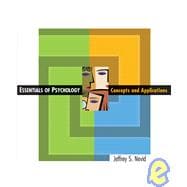
| Note | |
| Each Module includes a Review | |
| Concept Check | |
| Introduction to Psychology and Methods of Research | |
| Foundations of Modern Psychology | |
| Psychologists: Who They Are and What They Do | |
| Research Methods in Psychology | |
| Application: Becoming a Critical Thinker | |
| Biological Foundations of Behavior | |
| Neurons: The Body's Wiring | |
| The Nervous System: Your Body's Information Superhighway | |
| The Brain: Your Crowning Glory | |
| Methods of Studying the Brain | |
| The Divided Brain: Specialization of Function | |
| The Endocrine System: The Body's Other Communication System | |
| Genes and Behavior: A Case of Nature and Nurture | |
| Application: Biofeedback Training: Learning by Listening to the Body | |
| Sensation and Perception | |
| Sensing Our World: Basic Concepts of Sensation | |
| Vision: Seeing the Light | |
| Hearing: The Music of Sound | |
| Our Other Senses: Chemical, Skin, and Body Senses | |
| Perceiving Our World: Principles of Perception | |
| Application: Psychology and Pain Management | |
| Consciousness | |
| States of Consciousness | |
| Sleeping and Dreaming | |
| Altering Consciousness Through Meditation and Hypnosis | |
| Altering Consciousness Through Drugs | |
| Application: Getting Your Z's | |
| Learning | |
| Classical Conditioning: Learning Through Association | |
| Operant Conditioning: Learning Through Consequences | |
| Cognitive Learning | |
| Application: Putting Reinforcement into Practice | |
| Memory | |
| Remembering | |
| Forgetting | |
| The Biology of Memory | |
| Application: Powering Up Your Memory | |
| Thinking, Language, and Intelligence | |
| Thinking | |
| Language | |
| Intelligence | |
| Application: Becoming a Creative Problem Solver | |
| Motivation and Emotion | |
| Motivation: The "Whys" of Behavior | |
| Hunger and Eating | |
| Sexual Motivation | |
| Emotions | |
| Application: Managing Anger | |
| Human Development | |
| Prenatal Development: A Case of Nature and Nurture | |
| Infant Development | |
| Years of Discovery: Emotional, Social, and Cognitive Development in Childhood | |
| Adolescence | |
| Early and Middle Adulthood | |
| Late Adulthood | |
| Application: Living Longer, Healthier Lives | |
| Personality | |
| The Psychodynamic Perspective | |
| The Trait Perspective | |
| The Social-Cognitive Perspective | |
| The Humanistic Perspective | |
| Personality Tests | |
| Application: Building Self-Esteem | |
| Psychological Disorders | |
| What Is Abnormal Behavior? | |
| Anxiety Disorders | |
| Dissociative and Somatoform Disorders | |
| Mood Disorders | |
| Schizophrenia | |
| Personality Disorders | |
| Application: Suicide Prevention | |
| Methods of Therapy | |
| Types of Psychotherapy | |
| Biomedical Therapies | |
| Application: Getting Help | |
| Psychology and Health | |
| Stress: What It Is and What It Does to the Body | |
| Psychological Factors in Physical Illness | |
| Application: Taking the Distress Out of Stress | |
| Social Psychology | |
| Perceiving Others | |
| Relating to Others | |
| Group Influences on Individual Behavior | |
| Application: Compliance: Doing What Others Want You to Do | |
| Appendices | |
| Sample Answers to Thinking Critically About Psychology Questions | |
| Statistics Appendix Features Concept Charts Try This Out Application Modules | |
| Table of Contents provided by Publisher. All Rights Reserved. |
The New copy of this book will include any supplemental materials advertised. Please check the title of the book to determine if it should include any access cards, study guides, lab manuals, CDs, etc.
The Used, Rental and eBook copies of this book are not guaranteed to include any supplemental materials. Typically, only the book itself is included. This is true even if the title states it includes any access cards, study guides, lab manuals, CDs, etc.